Zhuoren Jiang
LangGFM: A Large Language Model Alone Can be a Powerful Graph Foundation Model
Oct 19, 2024
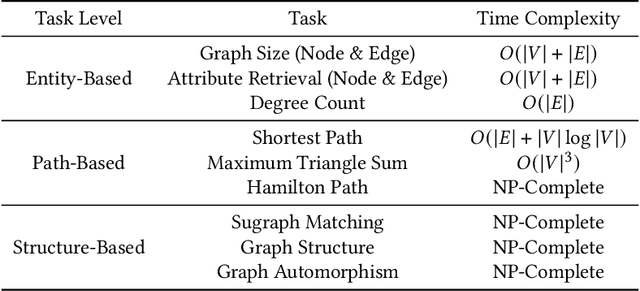

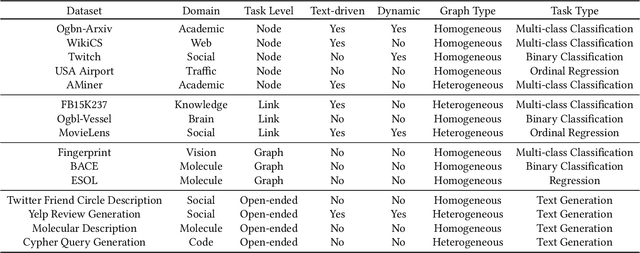
Abstract:Graph foundation models (GFMs) have recently gained significant attention. However, the unique data processing and evaluation setups employed by different studies hinder a deeper understanding of their progress. Additionally, current research tends to focus on specific subsets of graph learning tasks, such as structural tasks, node-level tasks, or classification tasks. As a result, they often incorporate specialized modules tailored to particular task types, losing their applicability to other graph learning tasks and contradicting the original intent of foundation models to be universal. Therefore, to enhance consistency, coverage, and diversity across domains, tasks, and research interests within the graph learning community in the evaluation of GFMs, we propose GFMBench-a systematic and comprehensive benchmark comprising 26 datasets. Moreover, we introduce LangGFM, a novel GFM that relies entirely on large language models. By revisiting and exploring the effective graph textualization principles, as well as repurposing successful techniques from graph augmentation and graph self-supervised learning within the language space, LangGFM achieves performance on par with or exceeding the state of the art across GFMBench, which can offer us new perspectives, experiences, and baselines to drive forward the evolution of GFMs.
Can Large Language Models Grasp Legal Theories? Enhance Legal Reasoning with Insights from Multi-Agent Collaboration
Oct 03, 2024


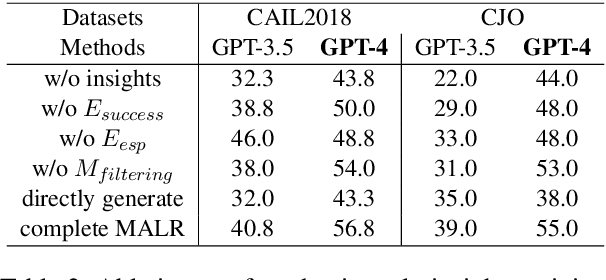
Abstract:Large Language Models (LLMs) could struggle to fully understand legal theories and perform complex legal reasoning tasks. In this study, we introduce a challenging task (confusing charge prediction) to better evaluate LLMs' understanding of legal theories and reasoning capabilities. We also propose a novel framework: Multi-Agent framework for improving complex Legal Reasoning capability (MALR). MALR employs non-parametric learning, encouraging LLMs to automatically decompose complex legal tasks and mimic human learning process to extract insights from legal rules, helping LLMs better understand legal theories and enhance their legal reasoning abilities. Extensive experiments on multiple real-world datasets demonstrate that the proposed framework effectively addresses complex reasoning issues in practical scenarios, paving the way for more reliable applications in the legal domain.
Evolving Knowledge Distillation with Large Language Models and Active Learning
Mar 11, 2024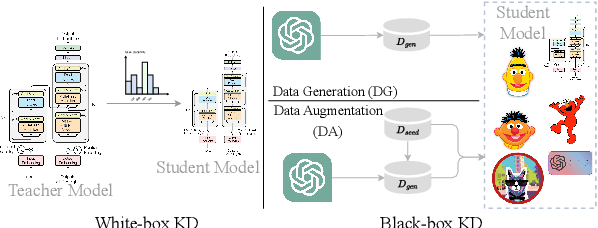
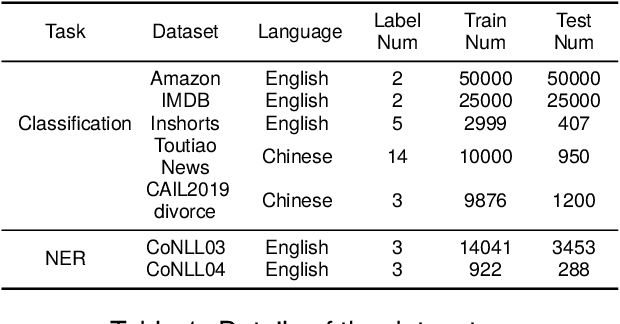


Abstract:Large language models (LLMs) have demonstrated remarkable capabilities across various NLP tasks. However, their computational costs are prohibitively high. To address this issue, previous research has attempted to distill the knowledge of LLMs into smaller models by generating annotated data. Nonetheless, these works have mainly focused on the direct use of LLMs for text generation and labeling, without fully exploring their potential to comprehend the target task and acquire valuable knowledge. In this paper, we propose EvoKD: Evolving Knowledge Distillation, which leverages the concept of active learning to interactively enhance the process of data generation using large language models, simultaneously improving the task capabilities of small domain model (student model). Different from previous work, we actively analyze the student model's weaknesses, and then synthesize labeled samples based on the analysis. In addition, we provide iterative feedback to the LLMs regarding the student model's performance to continuously construct diversified and challenging samples. Experiments and analysis on different NLP tasks, namely, text classification and named entity recognition show the effectiveness of EvoKD.
Tree-Based Hard Attention with Self-Motivation for Large Language Models
Feb 14, 2024



Abstract:While large language models (LLMs) excel at understanding and generating plain text, they are not specifically tailored to handle hierarchical text structures. Extracting the task-desired property from their natural language responses typically necessitates additional processing steps. In fact, selectively comprehending the hierarchical structure of large-scale text is pivotal to understanding its substance. Aligning LLMs more closely with the classification or regression values of specific task through prompting also remains challenging. To this end, we propose a novel framework called Tree-Based Hard Attention with Self-Motivation for Large Language Models (TEAROOM). TEAROOM incorporates a tree-based hard attention mechanism for LLMs to process hierarchically structured text inputs. By leveraging prompting, it enables a frozen LLM to selectively focus on relevant leaves in relation to the root, generating a tailored symbolic representation of their relationship. Moreover, TEAROOM comprises a self-motivation strategy for another LLM equipped with a trainable adapter and a linear layer. The selected symbolic outcomes are integrated into another prompt, along with the predictive value of the task. We iteratively feed output values back into the prompt, enabling the trainable LLM to progressively approximate the golden truth. TEAROOM outperforms existing state-of-the-art methods in experimental evaluations across three benchmark datasets, showing its effectiveness in estimating task-specific properties. Through comprehensive experiments and analysis, we have validated the ability of TEAROOM to gradually approach the underlying golden truth through multiple inferences.
Empowering Dual-Level Graph Self-Supervised Pretraining with Motif Discovery
Dec 19, 2023



Abstract:While self-supervised graph pretraining techniques have shown promising results in various domains, their application still experiences challenges of limited topology learning, human knowledge dependency, and incompetent multi-level interactions. To address these issues, we propose a novel solution, Dual-level Graph self-supervised Pretraining with Motif discovery (DGPM), which introduces a unique dual-level pretraining structure that orchestrates node-level and subgraph-level pretext tasks. Unlike prior approaches, DGPM autonomously uncovers significant graph motifs through an edge pooling module, aligning learned motif similarities with graph kernel-based similarities. A cross-matching task enables sophisticated node-motif interactions and novel representation learning. Extensive experiments on 15 datasets validate DGPM's effectiveness and generalizability, outperforming state-of-the-art methods in unsupervised representation learning and transfer learning settings. The autonomously discovered motifs demonstrate the potential of DGPM to enhance robustness and interpretability.
Towards Human-like Perception: Learning Structural Causal Model in Heterogeneous Graph
Dec 10, 2023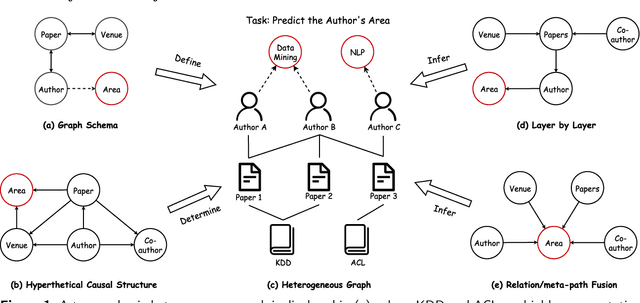

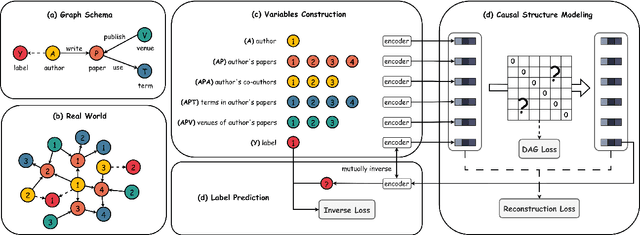

Abstract:Heterogeneous graph neural networks have become popular in various domains. However, their generalizability and interpretability are limited due to the discrepancy between their inherent inference flows and human reasoning logic or underlying causal relationships for the learning problem. This study introduces a novel solution, HG-SCM (Heterogeneous Graph as Structural Causal Model). It can mimic the human perception and decision process through two key steps: constructing intelligible variables based on semantics derived from the graph schema and automatically learning task-level causal relationships among these variables by incorporating advanced causal discovery techniques. We compared HG-SCM to seven state-of-the-art baseline models on three real-world datasets, under three distinct and ubiquitous out-of-distribution settings. HG-SCM achieved the highest average performance rank with minimal standard deviation, substantiating its effectiveness and superiority in terms of both predictive power and generalizability. Additionally, the visualization and analysis of the auto-learned causal diagrams for the three tasks aligned well with domain knowledge and human cognition, demonstrating prominent interpretability. HG-SCM's human-like nature and its enhanced generalizability and interpretability make it a promising solution for special scenarios where transparency and trustworthiness are paramount.
* 28 pages, 10 figures, 6 tables, accepted by Information Processing & Management
Disentangling the Potential Impacts of Papers into Diffusion, Conformity, and Contribution Values
Nov 15, 2023Abstract:The potential impact of an academic paper is determined by various factors, including its popularity and contribution. Existing models usually estimate original citation counts based on static graphs and fail to differentiate values from nuanced perspectives. In this study, we propose a novel graph neural network to Disentangle the Potential impacts of Papers into Diffusion, Conformity, and Contribution values (called DPPDCC). Given a target paper, DPPDCC encodes temporal and structural features within the constructed dynamic heterogeneous graph. Particularly, to capture the knowledge flow, we emphasize the importance of comparative and co-cited/citing information between papers and aggregate snapshots evolutionarily. To unravel popularity, we contrast augmented graphs to extract the essence of diffusion and predict the accumulated citation binning to model conformity. We further apply orthogonal constraints to encourage distinct modeling of each perspective and preserve the inherent value of contribution. To evaluate models' generalization for papers published at various times, we reformulate the problem by partitioning data based on specific time points to mirror real-world conditions. Extensive experimental results on three datasets demonstrate that DPPDCC significantly outperforms baselines for previously, freshly, and immediately published papers. Further analyses confirm its robust capabilities. We will make our datasets and codes publicly available.
H2CGL: Modeling Dynamics of Citation Network for Impact Prediction
Apr 16, 2023Abstract:The potential impact of a paper is often quantified by how many citations it will receive. However, most commonly used models may underestimate the influence of newly published papers over time, and fail to encapsulate this dynamics of citation network into the graph. In this study, we construct hierarchical and heterogeneous graphs for target papers with an annual perspective. The constructed graphs can record the annual dynamics of target papers' scientific context information. Then, a novel graph neural network, Hierarchical and Heterogeneous Contrastive Graph Learning Model (H2CGL), is proposed to incorporate heterogeneity and dynamics of the citation network. H2CGL separately aggregates the heterogeneous information for each year and prioritizes the highly-cited papers and relationships among references, citations, and the target paper. It then employs a weighted GIN to capture dynamics between heterogeneous subgraphs over years. Moreover, it leverages contrastive learning to make the graph representations more sensitive to potential citations. Particularly, co-cited or co-citing papers of the target paper with large citation gap are taken as hard negative samples, while randomly dropping low-cited papers could generate positive samples. Extensive experimental results on two scholarly datasets demonstrate that the proposed H2CGL significantly outperforms a series of baseline approaches for both previously and freshly published papers. Additional analyses highlight the significance of the proposed modules. Our codes and settings have been released on Github (https://github.com/ECNU-Text-Computing/H2CGL)
A Role-Selected Sharing Network for Joint Machine-Human Chatting Handoff and Service Satisfaction Analysis
Sep 17, 2021



Abstract:Chatbot is increasingly thriving in different domains, however, because of unexpected discourse complexity and training data sparseness, its potential distrust hatches vital apprehension. Recently, Machine-Human Chatting Handoff (MHCH), predicting chatbot failure and enabling human-algorithm collaboration to enhance chatbot quality, has attracted increasing attention from industry and academia. In this study, we propose a novel model, Role-Selected Sharing Network (RSSN), which integrates both dialogue satisfaction estimation and handoff prediction in one multi-task learning framework. Unlike prior efforts in dialog mining, by utilizing local user satisfaction as a bridge, global satisfaction detector and handoff predictor can effectively exchange critical information. Specifically, we decouple the relation and interaction between the two tasks by the role information after the shared encoder. Extensive experiments on two public datasets demonstrate the effectiveness of our model.
Adjacency List Oriented Relational Fact Extraction via Adaptive Multi-task Learning
Jun 03, 2021



Abstract:Relational fact extraction aims to extract semantic triplets from unstructured text. In this work, we show that all of the relational fact extraction models can be organized according to a graph-oriented analytical perspective. An efficient model, aDjacency lIst oRiented rElational faCT (DIRECT), is proposed based on this analytical framework. To alleviate challenges of error propagation and sub-task loss equilibrium, DIRECT employs a novel adaptive multi-task learning strategy with dynamic sub-task loss balancing. Extensive experiments are conducted on two benchmark datasets, and results prove that the proposed model outperforms a series of state-of-the-art (SoTA) models for relational triplet extraction.
 Add to Chrome
Add to Chrome Add to Firefox
Add to Firefox Add to Edge
Add to Edge